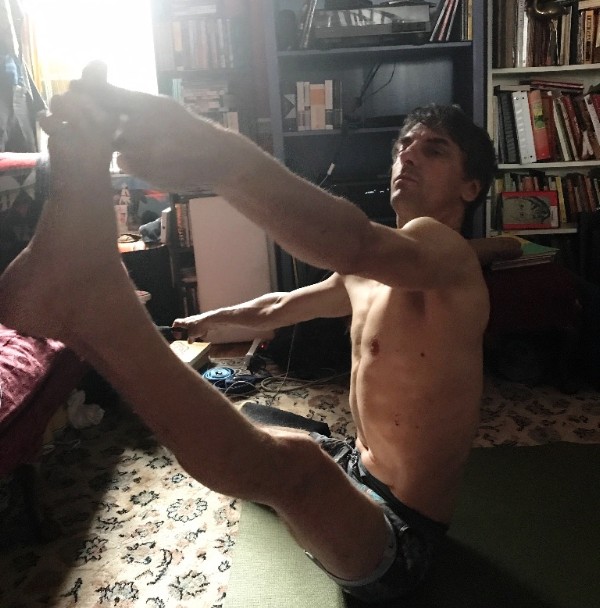
I imagine at times this can be hard on my practice partner but she also knows how thankful I am for her and our practice time. Here’s the deal the two main rooms in our house are separated not by walls but by a staircase that leads upstairs. The largest of these rooms is our official yoga space and therefore it has a sacred vibe, we keep it empty and spacious, yoga images and props are the only furniture. When I pass through the room during the day I want to practice in there. The other room on the other side of the staircase is full of all manner of clutter because we use it for almost everything else as a movie theatre, living room, dining room, study, library, and hang out room.
But when practice time arrives and we are both laying out our mats I become like a magnet attracted to solitude I am irresistibly pulled away from the designated space to the unofficial cluttered space. I can’t even fully explain it but I end up practicing in between hundreds of yoga books and film props. I can say in my defense that for three hours a day I convert our living room into a cave of solitude.
The room is no longer filled with bass amps and mannequins displaying costumes but a room that allows me to explore earth, space, water, air, and fire, a place that I carve out solitude. Sometimes I even wear an eye mask to block out all light and noise canceling headphones to block out all sound. But also I love that my practice partner is still beside me though at a distance. I gain essential inspiration and motivation just knowing that she is on the other side of the bannister toiling, breathing, sweating and seeking her own solitary bliss. Yogis understand that solitude is essential to discovering yoga but that being said, whether you practice by yourself or in a group setting, it can be challenging to carve out your internal cave of isolation. If you practice alone it can be challenging to simply roll out your mat and get started. If you practice in a group setting it will be easier to get started but it is easier to get distracted by what others are doing while you are practicing. Here are some tips for both settings.
If you practice alone motivation can be a real issue and therefore you have to have specific strategies that will help motivate you and minimize obstacles. For example, one strategy for winning the battle against inertia is to start practicing as soon as you wake up. I most often get out of bed and immediately take a laying down position against the wall where I do breathing exercises for 5 to 20 minutes. Occasionally I’ll go for a walk around the block. Sometimes I go right from the supine breathing position into my asana practice and sometimes I do seated pranayama first.
But the point is I get started before my mind has a chance to get started. I also recommend the simple strategy of making sure your room is well heated. A heated room can work wonders. For this reason one of my favorite places to practice is in the kitchen where I open the oven door and crank the dial up to 500 degrees. I also block the entrance to the room with a space heater and thereby make my own modern version of the old hatha yogi tapas inducing practice space of surrounding yourself with several wood fires. I also clean my practice space the night before. This will make it more attractive to roll out your mat in the morning. You need to try and eliminate any sort of variable (such as heat, cleanliness, distraction, etc) that could demotivate you. The message is if you have obstacles at home problem solve them! It’s funny how sometimes we’ll put up with inauspicious conditions when it wouldn’t be that hard to come up with a better set of conditions. Sometimes we get tunnel vision or become unnecessarily locked in. But removing little obstacles can help clear the way when you are a home practitioner. If you practice alone you need to take responsibility for creating and maintaining a sacred space.
On the other hand even though solitude is essential there’s nothing wrong with loving practicing with others. And you certainly don’t have to force yourself to practice alone especially if there’s a class you can attend. Practicing in a group requires different strategies for example when surrounded by others you can make your own imaginary meditation cell. Clearly define the territory of your mat, psychically wall your self off the rest of the room and withdraw your senses into your own body. You can do this in a friendly, positive way without negatively shutting out others or the world. Place the majority of your attention inside your own skin, make an extra effort to create an atmosphere of clear inner space and thereby simulate solitude. When you do find yourself becoming distracted by any outer variable then it is your job to withdraw your attention internally. With practice and repetition it is amazing how effectively you can cease to notice what is happening outside of you.
Comments
No comments.